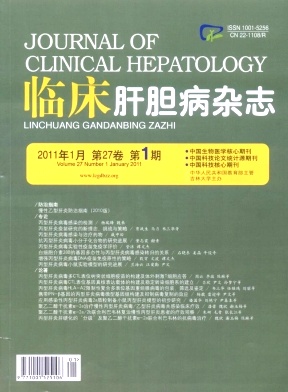| [1] | Du YiChao, Zhang Hao, Zhong FuRui, Cheng HuanLi, Lai Li, Qian BaoLin, Tan Peng, Xia XianMing, Fu WenGuang. Protective effect of pinocembrin in a mouse model of liver injury induced by acetaminophen[J]. Journal of Clinical Hepatology, 2020, 36(3): 608-611. doi: 10.3969/j.issn.1001-5256.2020.03.027 |
| [2] | WANG WenHui, DUAN XuHua, LI Hao, LI FengYao, JU ShuGuang, WANG ManZhou, REN JianZhuang, HAN XinWei. Effect of arsenic trioxide-loaded CalliSpheres beads in the treatment of rabbits with VX2 liver tumor[J]. Journal of Clinical Hepatology, 2020, 36(12): 2730-2734. doi: 10.3969/j.issn.1001-5256.2020.12.018 |
| [3] | Wang LiBo, Sun YuLing. Establishment of Budd-Chiari syndrome models and related research advances[J]. Journal of Clinical Hepatology, 2020, 36(4): 908-911. doi: 10.3969/j.issn.1001-5256.2020.04.044 |
| [4] | Ha FuShuang, Han Tao, Liang Ning, Nie XinHua, Zhu ZhengYan. Effect of recombinant human granulocyte colony-stimulating factor on rats with acute liver failure[J]. Journal of Clinical Hepatology, 2019, 35(7): 1565-1569. doi: 10.3969/j.issn.1001-5256.2019.07.028 |
| [5] | Wang Hao, He Cheng, Chen Hao, Ou YangZhongMin, Liu ZhiQiang. Value of Gd-EOB-DTPA-enhanced MRI in the assessment of liver function in dogs with acute liver failure[J]. Journal of Clinical Hepatology, 2019, 35(7): 1576-1581. doi: 10.3969/j.issn.1001-5256.2019.07.030 |
| [6] | Zhang YongChao, Bi YanZhen, Fang Xiao, Wang QuanYi, Wang QuanQuan, Tang HuiXin, Kong LingBin, Chen Yu, Duan ZhongPing, Shu ZhenFeng, Hong Feng. Protective effect of probiotics in rats with acute-on-chronic liver failure and related mechanism[J]. Journal of Clinical Hepatology, 2019, 35(7): 1570-1575. doi: 10.3969/j.issn.1001-5256.2019.07.029 |
| [7] | Zhou QiFeng, Zhang LingQiang, Liao MengJiao, Pang MingQuan, Li MengXuan, Ren Li, Fan HaiNing. Establishment of a subcutaneous xenograft tumor model of alveolar echinococcosis in nude mice[J]. Journal of Clinical Hepatology, 2018, 34(3): 588-590. doi: 10.3969/j.issn.1001-5256.2018.03.028 |
| [8] | Zhang JiYu, Fan XingLiang. Research advances in the mouse model of primary biliary cholangitis[J]. Journal of Clinical Hepatology, 2017, 33(11): 2235-2238. doi: 10.3969/j.issn.1001-5256.2017.11.041 |
| [9] | Wang BaoJu, Zhu Bin, Guo WeiNa, Yang DongLiang. Establishment and application of in vitro and in vivo models of hepatitis B virus infection[J]. Journal of Clinical Hepatology, 2017, 33(8): 1458-1464. doi: 10.3969/j.issn.1001-5256.2017.08.009 |
| [10] | Li Dong, Lu ZhongHua, Gan JianHe. Establishment of a rat model of early-stage liver failure and Th17/Treg imbalance[J]. Journal of Clinical Hepatology, 2016, 32(5): 928-932. doi: 10.3969/j.issn.1001-5256.2016.05.025 |
| [11] | Chen Jing, Liu XiaoYan, Yang HaoZhen, Huang Kun, Hu JinHua, Xin ShaoJie. Study on p-p38 expression and its significance in liver tissues of mice with acute liver failure and patients with HBV-related acute-on-chronic liver failure[J]. Journal of Clinical Hepatology, 2015, 31(4): 556-559. doi: 10.3969/j.issn.1001-5256.2015.04.019 |
| [12] | Pang GuoJin, Chen ShuangJun, Zhao WeiHua, Liu TianHui, Wang Ping, You Hong, Cong Min. Dynamic change of hepcidin in liver fibrosis induced by CCl4 among mice[J]. Journal of Clinical Hepatology, 2015, 31(3): 418-423. doi: 10.3969/j.issn.1001-5256.2015.03.025 |
| [13] | Zhu Ting, Nie QingHe. New progress in development of animal models of hepatitis C virus infection[J]. Journal of Clinical Hepatology, 2015, 31(1): 123-126. doi: 10.3969/j.issn.1001-5256.2015.01.028 |
| [14] | Zhang YanFang, Zhao DongMei, Zhang YanMin, Wang Wei, Zhao HongRu. An analysis of related factors for hepatitis C genotyping and sustained virologic response in Xingtai, China[J]. Journal of Clinical Hepatology, 2015, 31(11): 1845-1848. doi: 10.3969/j.issn.1001-5256.2015.11.018 |
| [15] | Huang HaiYan, Xin YongNing, Jiang Man, Jin WenWen, Jiang XiangJun, Xuan ShiYing. Research advances in animal models of nonalcoholic fatty liver disease[J]. Journal of Clinical Hepatology, 2014, 30(9): 948-953. doi: 10.3969/j.issn.1001-5256.2014.09.028 |
| [16] | Yang RuiFeng, Wei Lai. Detection of hepatitis C virus infection[J]. Journal of Clinical Hepatology, 2011, 27(1): 1-7. |
| [17] | Jiang Han, Wang XueFeng, Wang ZiHao, Xu Bin, Shi WeiBin. The establishment of rabbit VX2 hepatic tumor model and the application of nano-scale microbubble contrast agent in the diagnosis of this model[J]. Journal of Clinical Hepatology, 2011, 27(7): 746-748. |
| [18] | Ye LiHong, Wang ChongKui, Tian YueYang, Xu Yi, Zheng HaoJie, Shao ShiXiang, Dai ErHei. Effect of Ruangan Huajian granule on hepatic expression of PDGF - B in C57 mice with experimental hepatic fibrosis[J]. Journal of Clinical Hepatology, 2011, 27(10): 1047-1050. |
| [19] | Sun LinLin, Shi Jun, Hao JingHua, Ren WanHua, Yan ChunYing, Zhang Jie, Lin XiaoYan, Cui Bin. Effect of high-fat diet on establishment of a rat non-alcoholic steatohepatitis/liver fibrosis model[J]. Journal of Clinical Hepatology, 2011, 27(3): 254-257+272. |
| [20] | Song Yu, Yu Zheng, Fan YanHua, Yao ShuKun, Wang TaiLing. A rat model of hepatic veno-occlusive disease induced by the Gynura root water decoction[J]. Journal of Clinical Hepatology, 2011, 27(8): 860-864. |













 DownLoad:
DownLoad: